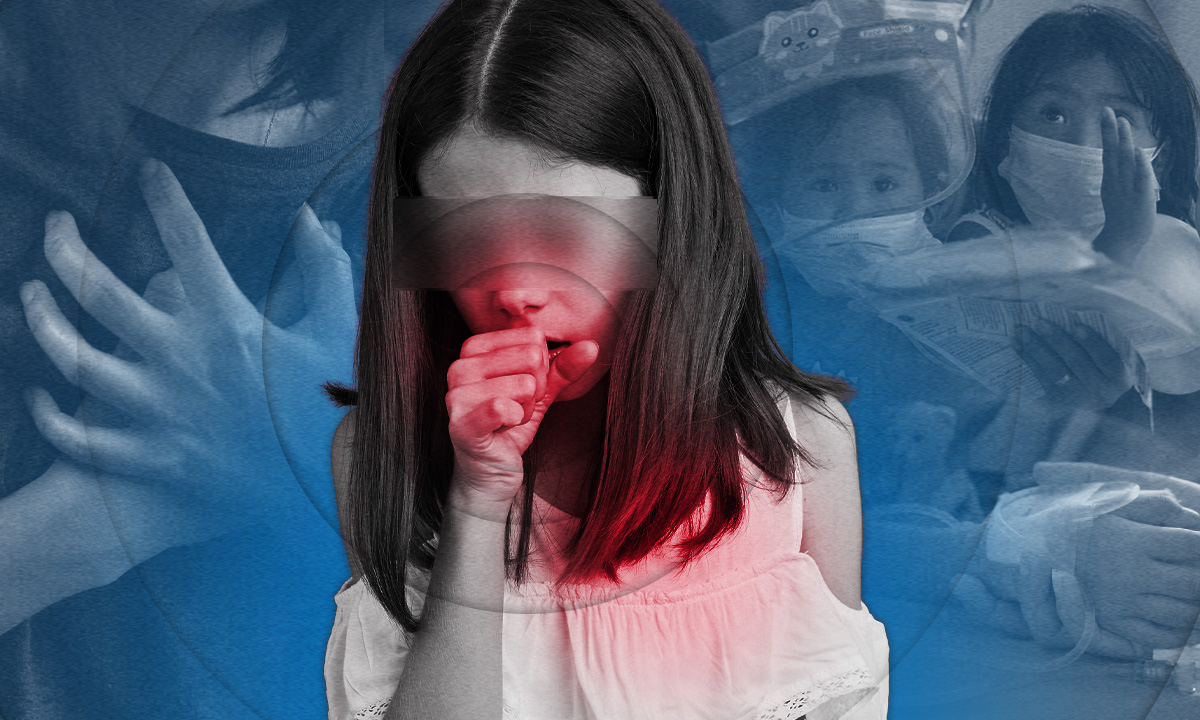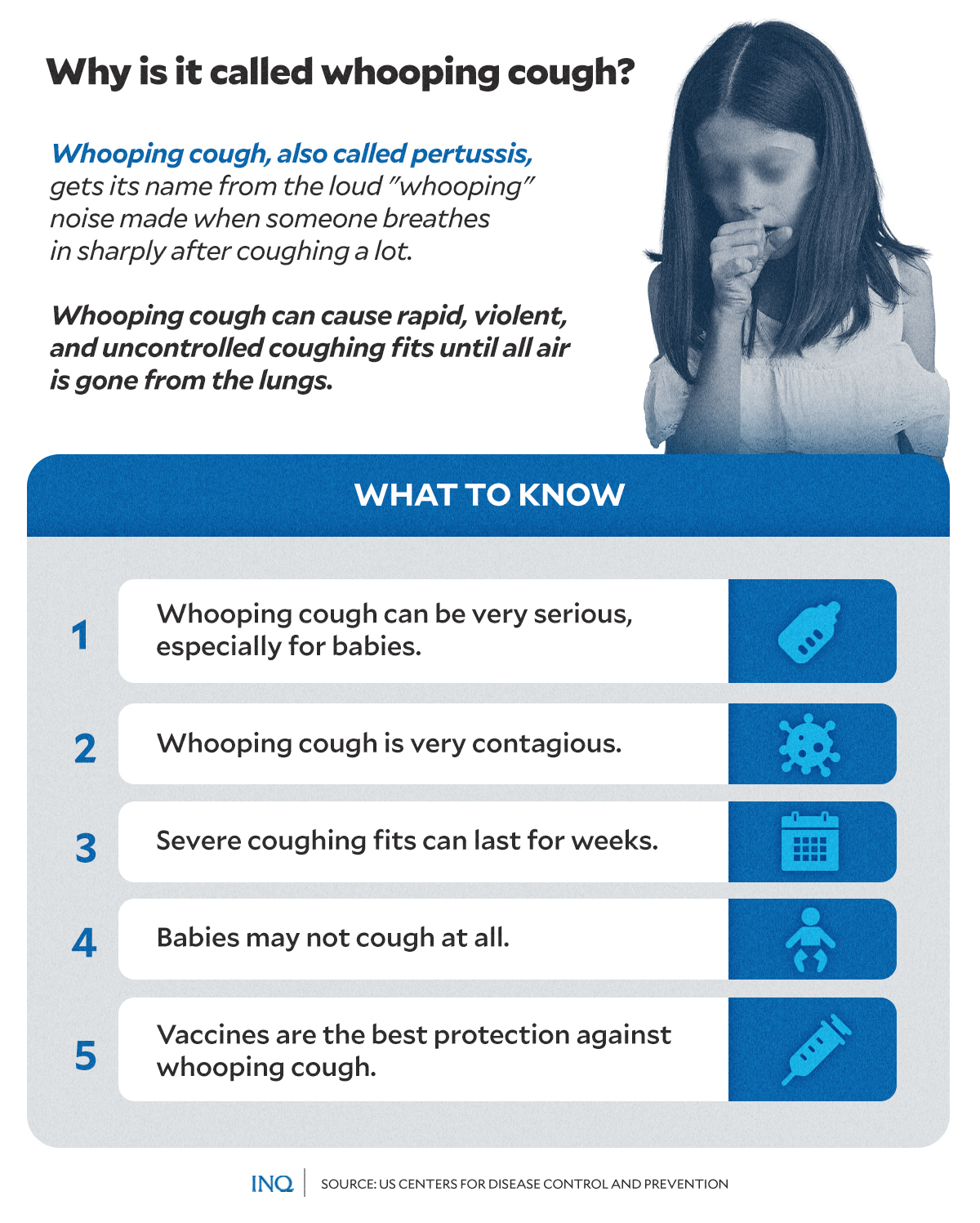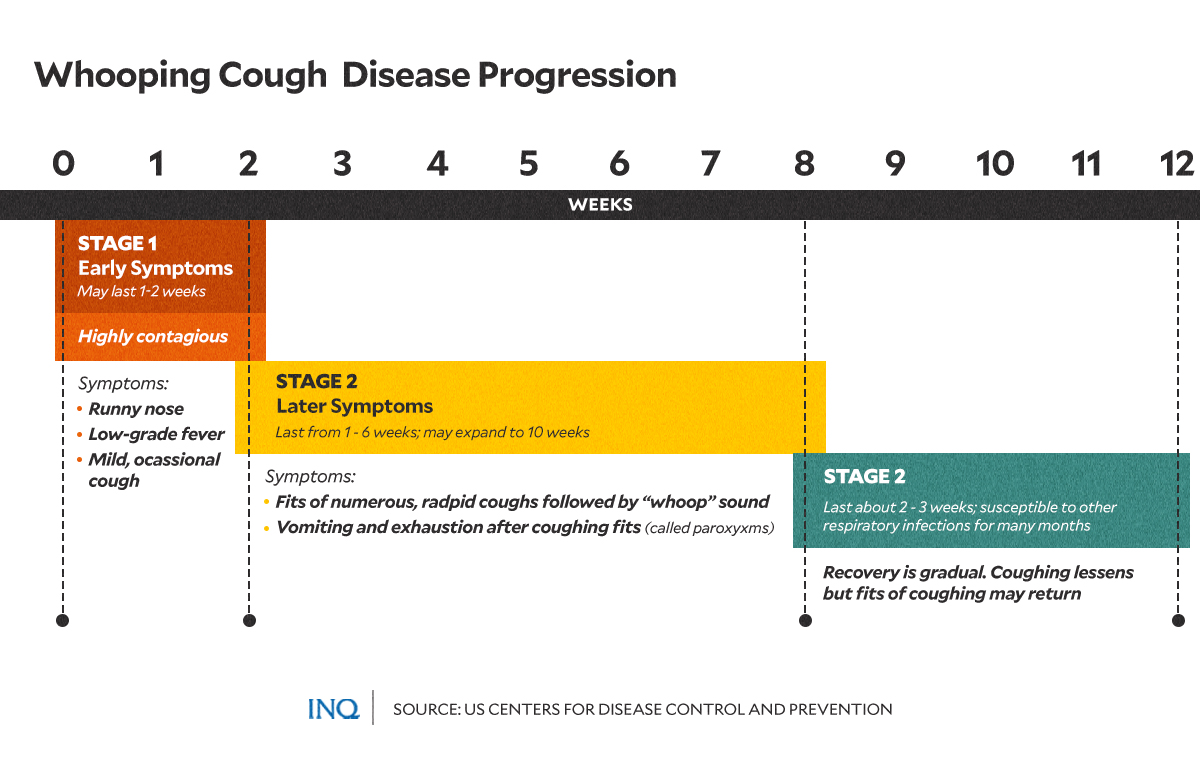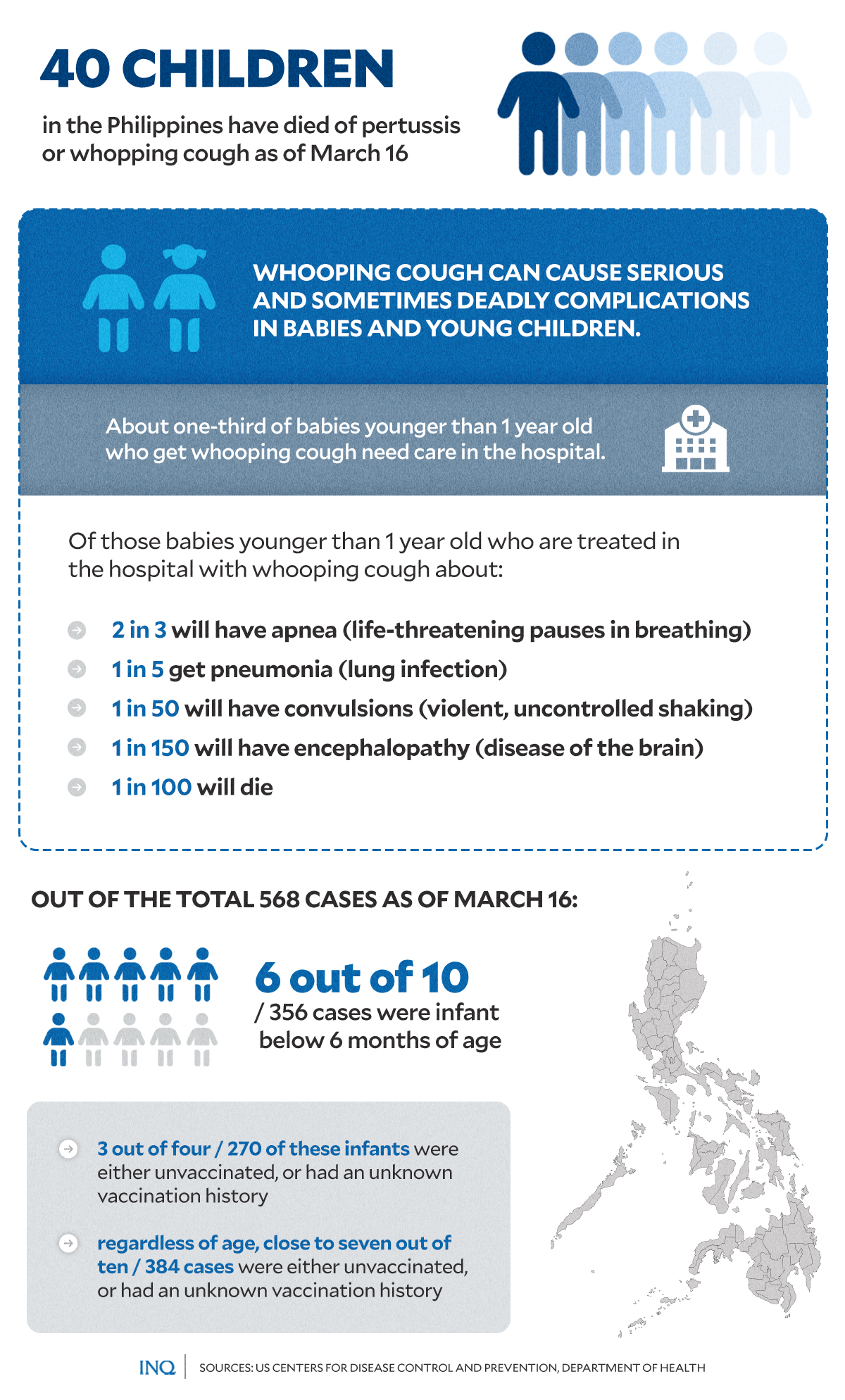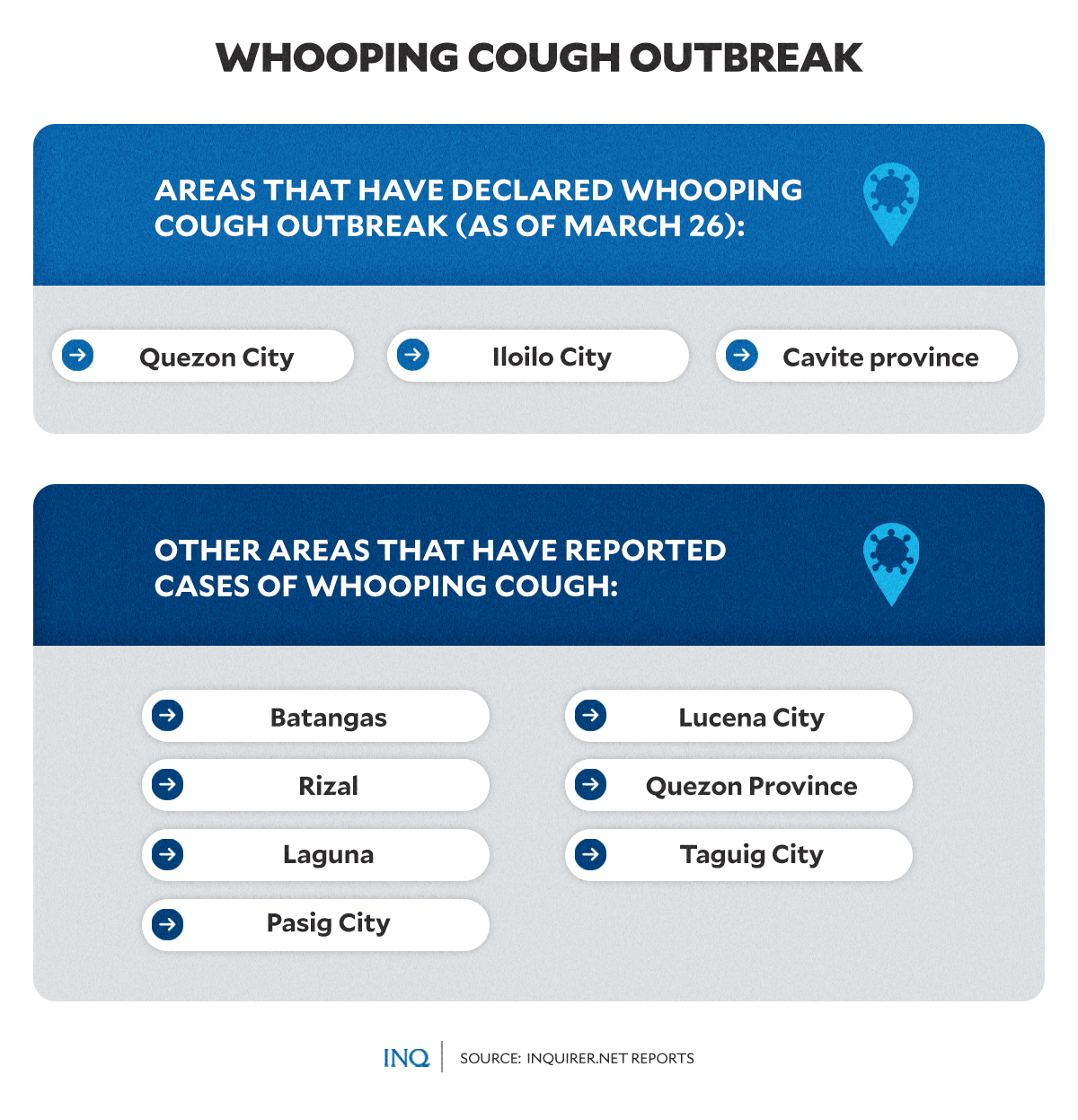Whooping cough: It’s not just a cough
(First of two parts)
MANILA, Philippines—Despite the supposed availability of vaccines, several areas in the Philippines are hit by an outbreak of the highly contagious whooping cough, with over 500 reported cases, mainly involving children.
Whooping cough, also called pertussis, is a respiratory disease caused by Bordetella pertussis bacteria. It causes rapid, violent, and uncontrolled coughing fits, which can go on for up to 10 weeks or more.
According to the US Centers for Disease Control and Prevention (CDC), the disease got its name from the loud “whooping” noise made when someone breathes in sharply after coughing a lot.
US CDC also warned that whooping cough is very contagious, explaining that the bacteria causing the disease can spread easily from person to person, mainly through droplets produced by coughing and sneezing.
Article continues after this advertisement“Some people have mild symptoms and don’t know they have whooping cough, but they can still spread the bacteria that cause it to others, including babies,” the CDC added.
Article continues after this advertisementHere are some things to know about the disease and why it is said to be very dangerous, particularly to infants and young children.
Symptoms to look out for
The first symptoms of whooping cough, according to the World Health Organization (WHO), generally appear between seven to 10 days after infection.
CDC said the first symptoms of the disease usually develop within five to 10 days after coming into contact with the bacteria that causes it.
Among the early symptoms, which can last for one to two weeks, include:
- runny or stuffed-up nose
- low-grade fever (less than 38°C)
- mild, occasional cough (babies, however, do not do this)
- apnea (life-threatening pauses in breathing) and cyanosis (turning blue or purple) in babies and young children
However, CDC explained that in its early stages, whooping cough appears to be nothing more than the common cold. This causes doctors and health experts not to suspect or diagnose until more severe symptoms appear.
Around one to two weeks after initial symptoms appear, individuals with whooping cough can experience severe coughing spells known as paroxysms. These intense bouts of coughing can persist from one to six weeks and sometimes up to 10 weeks.
CDC stressed that as the condition progresses, the frequency and severity of these coughing fits tend to increase.
During these fits, individuals might:
- emit a high-pitched “whooping” sound when they finally manage to take a breath after coughing
- experience vomiting either during or following the coughing episodes
- feel exhausted after each coughing spell, although they may appear normal between episodes
- struggle to breathe
“People with pertussis are most contagious up to about three weeks after the cough begins, and many children who contract the infection have coughing spells that last 4 to 8 weeks,” WHO said.
Babies, children: more at risk
Compared to teens and adults, especially those vaccinated against whooping cough, the infection is much more dangerous — and even deadly — in infants. WHO noted that whooping cough is a “significant” cause of disease and death among infants across the globe.
Data from the recent whooping cough outbreak in the Philippines showed that the majority of recorded cases were in infants.
Based on figures from the Department of Health, out of the total 558 cases recorded in the country as of March 16, 356 cases — or 6 out of 10 — were infected infants who are below 6 months of age.
READ: DOH sees possible Holy Week hike in pertussis cases
Of those cases, three out of four or 270 infants were either unvaccinated against whooping cough or had an unknown vaccination history.
“In the first 6 months of life, babies are at high risk for complications from whooping cough, even if they are healthy,” CDC explained.
“This is because their immune systems are still developing. In fact, babies younger than 2 months old only have the antibodies they get from their mother to help protect them,” CDC said, adding that women should get Tdap vaccine shots during pregnancy to increase protective antibodies.
Life-threatening complications
In some cases, whooping cough can trigger intense coughing episodes in infants and young children, potentially causing serious complications such as breathing difficulties and challenges with eating and drinking.
However, the CDC said most infants with whooping cough do not cough at all. Instead, they could show signs of turning blue or experiencing breathing difficulties.
Additionally, their symptoms could mimic those of a common cold throughout the duration of their illness, not just in the initial stages.
These issues can escalate, posing a life-threatening risk to this vulnerable age group.
Data indicate that approximately one-third of infants under one year old who contract whooping cough require hospitalization. The younger the infant, the higher the probability they will need hospital treatment.
Of those babies younger than one year old who are treated in the hospital with whooping cough, some will experience specific complications:
- 2 in 3 babies will have apnea
- 1 in 5 will get pneumonia or lung infection
- 1 in 50 will have convulsions or violent and uncontrolled shaking
- 1 in 150 will have encephalopathy (disease of the brain)
- 1 in 100 will die
As of March 16, 40 children in the country have died from whooping cough, according to Assistant Health Secretary Albert Domingo.
READ: DOH: 40 child deaths due to pertussis logged so far this year
However, amid the significant rise in whooping cough cases, the health department has reminded the public that the disease is treatable and preventable.
“The medical field has known pertussis for a long time now,” said Health Secretary Dr. Teodoro J. Herbosa in a statement.
“We have antibiotics that can treat it. Vaccines are safe and effective against whooping cough,” Herbosa said.
“DOH is redistributing on-hand doses to where they are needed the most,” he said.
“In consultation with President [Ferdinand] Marcos [Jr.], I have already ordered to fast-track the arrival of 3 million more doses. Please be assured while also being alert. We can fight this,” he added.
(Next: Whooping cough treatment, prevention. Routine immunization in PH.)
